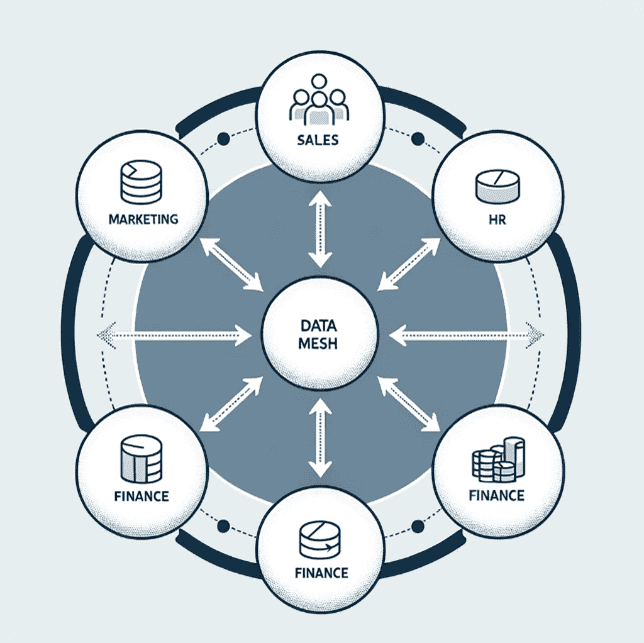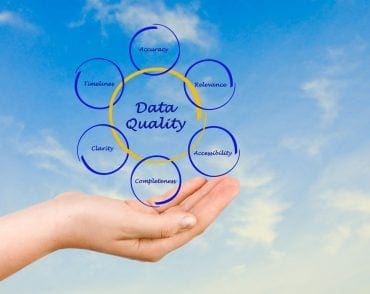
As businesses continue to evolve in the digital age, adopting a Data Mesh framework offers a path to more agile, efficient, and impactful data management.
In today’s rapidly evolving business environment, organizations are focused on achieving better decision-making, fostering innovation, and maintaining agility. However, data chaos—characterized by fragmented and siloed information—often impedes these goals, preventing businesses from fully leveraging their data. This inefficiency hinders growth and stifles innovation. Diverse industries are successfully implementing Data Mesh to address these challenges and unlock the full potential of their data. Data Mesh, a revolutionary concept introduced by Zhamak Dehghani in 2019, provides a transformative solution. By decentralizing data ownership and adopting a domain-oriented approach, Data Mesh enables organizations to unlock the full potential of their data. This leads to improved outcomes, greater innovation, and enhanced agility, which are essential for thriving in the digital age. Organizations should care about this paradigm shift because it directly impacts their ability to stay competitive, respond to market demands, and drive sustainable growth.
A Data Mesh architecture decentralizes data ownership, embedding it within domain-specific teams, thus transforming data into a well-managed and accessible asset. This shift aligns data management with business objectives and fosters a culture of accountability and collaboration. Thought leaders highlight the importance of this transformation, emphasizing that a well-executed Data Mesh strategy enhances data accessibility and empowers teams to drive business outcomes more effectively. A Data Mesh strategy democratizes data, thus breaking down barriers and setting the stage for collaboration and innovation. This helps to transcend industry silos and allows organizations to unlock their true potential.
JPMorgan Chase, a leading global financial services firm, faced significant challenges with data silos and inconsistent data quality across their operations. Their traditional centralized data management system was not keeping pace with the evolving needs of the business. To address these issues, JPMorgan Chase adopted a Data Mesh architecture, decentralizing data ownership by embedding it within domain-specific teams. Each team was responsible for managing their own data as a product, ensuring high quality and accessibility. Simultaneously, JPMorgan integrated Data Fabric platforms to unify disparate data sources, enhance data governance, and streamline data access and utilization. As a result, JPMorgan reported improved data accuracy, relevance, and up-to-dateness, leading to better decision-making. The decentralized approach empowered teams to experiment and innovate without bureaucratic delays, resulting in more agile responses to market changes and business needs. JPMorgan illustrates the practical benefits of adopting a Data Mesh framework in a financial context, highlighting significant improvements in efficiency, cost savings, and data quality.
To further enhance data management and integration, JPMorgan incorporated Data Fabric Platforms with Data Mesh principles. Data Fabric platforms serve as centralized hubs for data integration, management, and analysis, ensuring consistent data quality, security, and compliance. By unifying disparate data sources and formats, organizations can streamline data access, processing, and utilization.
See also: From Data Warehouse to Data Mesh: Usable Data is Still Key
A Closer Look at Data Mesh
Defining Data Mesh and Data Fabric can be better understood through analogies. Data Mesh can be thought of as a collaborative team of authors, each responsible for their own chapters within a book. Each author (domain-specific team) writes, edits, and ensures the quality of their chapters (data) independently. The chapters are then compiled into a cohesive book, maintaining the unique style and perspective of each author while contributing to the overall narrative. This decentralized approach ensures that each section is meticulously crafted by those most familiar with the content, promoting high quality and relevance.
In contrast, Data Fabric is akin to a well-designed transportation network in a city. This network connects various parts of the city (data sources) through an integrated system of roads, bridges, and tunnels (data integration technologies). Commuters (data users) can travel seamlessly across the city without needing to understand the intricate details of each connection. A central authority (centralized data governance) oversees the network, ensuring it operates smoothly, managing traffic, and maintaining infrastructure. The focus here is on creating a unified, interconnected system that provides easy and consistent access to all parts of the city.
The core principles of Data Mesh include domain-oriented decentralized data ownership, treating data as a product, providing self-serve data infrastructure, and implementing federated computational governance. Assigning data ownership to domain-specific teams ensures accountability and contextual relevance. Treating data with the same care and attention as products ensures high quality, usability, and accessibility. Providing teams with the tools and capabilities to autonomously manage their data needs enhances agility and innovation. Implementing governance policies that are enforced through automation and adaptable to the decentralized model ensures robust data management, security, and compliance.
To better visualize this concept, consider the following diagram illustrating the architecture:

As shown, each domain-specific team (Marketing, Sales, HR, Finance) owns its data and connects to a central Data Mesh Platform. This setup facilitates both centralized data integration and decentralized data ownership, enabling efficient data management and cross-domain analysis.
The advantages of Data Mesh are substantial. Enhanced agility allows faster responses to changing business needs and market conditions. Improved data quality ensures that domain-specific teams maintain data accuracy, relevance, and up-to-datedness. Increased innovation empowers teams to experiment and innovate without bureaucratic delays. Better alignment with business goals ensures that data initiatives are linked to business outcomes, driving more impactful results and enhancing customer satisfaction.
Transitioning from a chaotic data environment to a streamlined Data Mesh framework involves several actionable steps. Organizations should assess their current data landscape to identify existing data silos, governance structures, and pain points. Educating and aligning stakeholders ensures that all relevant parties understand the principles and benefits of Data Mesh. Piloting the approach with select domains helps evaluate and refine the methodology. Implementing self-serve data infrastructure equips teams with the necessary tools and platforms, ensuring secure and efficient data management. Establishing federated governance develops and enforces policies that support decentralization. Scaling the implementation gradually, based on learnings from the pilot phase, ensures a smooth transition.
Use Cases
Real-world examples underscore the efficacy of Data Mesh in practice. In the manufacturing sector, adopting a Data Mesh framework has enabled companies to streamline their supply chain operations, leading to more efficient production processes and improved product quality. By leveraging AI and advanced analytics within the Data Mesh, manufacturers can predict maintenance needs, optimize inventory, and enhance overall operational efficiency. Key performance indicators for AI success in manufacturing demonstrate that integrating Data Mesh with AI and advanced analytics can significantly boost productivity and reduce costs, highlighting the tangible benefits of a well-implemented Data Mesh strategy.
This comprehensive exploration of transitioning from a chaotic data environment to a streamlined Data Mesh framework underscores the potential of this innovative approach. By leveraging insights from thought leaders and integrating innovative platforms, organizations can transition from data chaos to a coherent strategy that unlocks the true value of their data, driving sustained innovation and a competitive edge. As businesses continue to evolve in the digital age, adopting a Data Mesh framework offers a path to more agile, efficient, and impactful data management.
To successfully navigate this transition, it is crucial to engage professionals who understand and have proven experience in implementing Data Mesh and Data Fabric solutions. These experts can guide organizations through the complexities of decentralized data management, ensuring that the transition is smooth and that the benefits of enhanced data accessibility, quality, and innovation are fully realized.






























